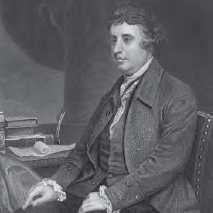The Enlightenment PeriodCounter-Enlightenment Figures |
What are some key facts about Edmund Burke’s life? |
Edmund Burke was born in Ireland in 1729. He attended Trinity College in Dublin, and then moved to London, hoping to read law, but he was never “called to the bar.” Instead, he wrote A Vindication of Natural Society and Philosophical Inquiry into Our Ideas on the Sublime and the Beautiful, both published in 1756 by the bookseller Robert Dodley, who also commissioned him to write an Abridgement of the History of England, which he never completed. His Vindication was deliberately written in the style of the Tory statesman Lord Bollingbroke, who in overblown ways praised a pure state of nature compared to civilization. Although Burke argued for the opposite, his imitation of Bollingbroke was so convincing that many readers thought Bollingbroke had written it.
Burke’s theory of art was opposed to the classicist value of clarity. He thought that great art is mysterious and evocative and that the sublime inspires fear. He wrote: “It is our ignorance of things that causes all our admiration and chiefly excites our passions.”

